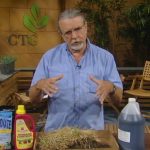My Zoysia grass turned yellow and patchy. What happened?
We’re getting lots of questions about lawn fungal disease due to all the moist cloudy weather, in addition to all the rain!
We thank Christine Sills for her picture and question about her lawn decline that started last June. Until then, her Zeon zoysia in front was healthy and thick, like her zoysia in back. Then, in June, a yellow spot started developing and expanding. Now it’s a round circle of bare dirt.
Christine says that the problem area is sloping and doesn’t collect much water, so she hesitated to think the problem was disease-oriented. And a lawn maintenance company told her that she had chinch bugs because she wasn’t watering enough. Despite the company’s treatments, aeration, and monthly fertilizers, things were just getting worse.
So, what’s going on here? There are a lot of details to take into account, so we first sent Christine’s photos to Wizzie Brown, my fabulous entomology colleague at the Texas A&M AgriLife Extension Service, to see if she thought the chinch bug diagnosis was correct. But she says that’s not likely. Insect damage tends to be more patchy, and the damage here is clearly round, and spreading out uniformly.
That uniformity of expansion is more associated with cultural practices, i.e. irrigation, fertilization, and soil compaction problems, or with disease issues. Since Christine mentions that she had the lawn aerated and fertilized, we concluded that the damage was likely caused by brown patch, a fungal disease that thrives in just the conditions that were present in Christine’s yard at the time she first noticed problems.
Brown patch is most likely to become a problem during the late spring or early summer, when days are very warm but nights are still relatively cool. Heavy dew is also most prevalent under these conditions, giving the fungal spores all the elements that it needs to have explosive growth.
Since the lawn company advised her to water MORE, that simply made the problem worse.
So, what should be done to rejuvenate the area and keep the disease from returning and spreading…first, I would suggest aerating again, to be certain that there’ll be good drainage.
Next, remove all of the affected turf, plus a little extra around the perimeter, just to be sure you’ve removed all of the potential for any errant spores to regrow. Then treat preventatively with a labeled fungicide and resod the area. And be sure not to over-water. Especially during spring and early summer, when the air is much more humid.
John Dromgoole adds that Actinovate is a great natural fungicide.
He also recommends spraying the lawn mower blades and wheels with Lysol to prevent spreading it to the healthy parts. Also, make sure the blades are good and sharp so the grass has a clean cut.
Plus, instead of waiting for the grass to fill in, cut the infected part out, treat the soil with compost and Actinovate, and go ahead and replace the sod in that spot.
To see if you have chinch bugs, John recommends this simple method: Drive a bottomless can or small bucket into the problem area and fill it with water. The chinch bugs will float.
Here are more John Dromgoole tips for dealing with brown patch.

 Brent Pemberton
Brent Pemberton Daphne Richards
Daphne Richards Brown Patch
Brown Patch